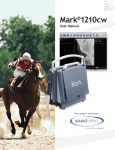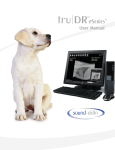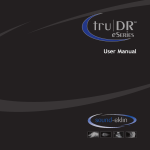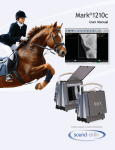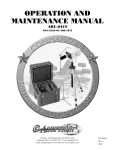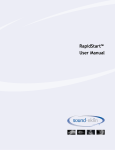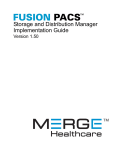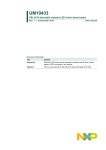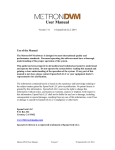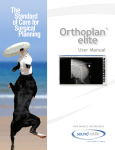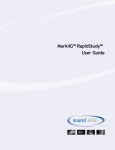Download TruDR® Touch Software User Manual
Transcript
TruDR® Touch Software User Manual TruDR® Touch Software Table of Contents TruDR® Touch Software User Manual Important Safety Information................................................................................ i Note.......................................................................................................... i Warning...................................................................................................... i Caution...................................................................................................... i Disposal .................................................................................................... ii Specifications .............................................................................................iii Chapter 1: Opening TruDR® Touch Software ............................................................ 1 Chapter 2: Adding Users..................................................................................... 2 Chapter 3: Patient Information............................................................................. 4 Searching and Adding Patients ........................................................................ 4 Editing an Existing Patient’s Information ........................................................... 6 Creating a New Study for an Existing Patient ...................................................... 6 Chapter 4: Creating Radiographs .......................................................................... 7 Choosing Anatomy and Positioning ................................................................... 7 Acquiring Radiographs .................................................................................. 9 Cropping a Radiograph................................................................................. 11 Applying a Default Image Orientation............................................................... 13 Urgent DICOM Send...................................................................................... 16 Creating a Study Using Modality Work List......................................................... 17 Chapter 5: Protocols......................................................................................... 19 Using Protocols........................................................................................... 19 Adding New Protocols...................................................................................22 Editing Existing Protocols..............................................................................25 Renaming Protocols.....................................................................................26 Deleting Protocols....................................................................................... 27 Chapter 6: Managing Studies............................................................................... 29 Adding New Images to an Existing Study............................................................ 29 Reviewing a Study.......................................................................................30 10192013 Sound-Eklin® TruDR® Touch Software Table of Contents TruDR® Touch Software User Manual (continued) Chapter 7: Exporting Images to a Folder................................................................ 33 Chapter 8: Transferring Studies to SoundBank™ or Storage.......................................... 35 Transferring Individual Studies to SoundBank™ or Storage...................................... 37 Transferring DICOM Batch to SoundBank™ or Storage............................................38 Confirm Storage of a Study............................................................................ 39 Chapter 9: Adding and Editing a DICOM Location......................................................40 Chapter 10: Reporting ...................................................................................... 43 Radiology Report........................................................................................ 43 AHAA Report............................................................................................. 43 Study Summary.......................................................................................... 43 Appendix A: Digital Radiography Technique Charts...................................................44 Adult Equine..............................................................................................44 Juvenile Equine..........................................................................................45 Small Animal..............................................................................................46 Appendix B: Assembly Instructions for Rayence 1210cw Handle................................... 47 Appendix C: Wireless Rayence 1210cw Plate Functionality..........................................48 Signal and Battery Strength ..........................................................................49 Appendix D: Technique and Positioning Guide.........................................................50 Position Distance........................................................................................ 51 Too Large of a Distance................................................................................ 51 Too Small of a Distance................................................................................. 51 Ideal Technique and Distance......................................................................... 52 Appendix E: Technical Support............................................................................ 53 Shipping Address......................................................................................... 53 Technical Support....................................................................................... 53 Website.................................................................................................... 53 Sound-Eklin® Important Safety Information Note Read all the instructions before connecting or operating the component Keep this manual so you can refer to these safety instructions. Warning There are no user serviceable parts inside. Refer all servicing to qualified service personnel. To reduce the risk of fire or electric shock, do not expose the unit to moisture or water. Do not allow foreign objects to get into the enclosure. If the unit is exposed to moisture, or a foreign object gets into the enclosure, immediately disconnect the power cord from the wall. Take the unit to a qualified service person for inspection and necessary repairs. Caution Heed all warnings and safety information in these instructions and on the product itself. Follow all operating instructions. • Clean the enclosure only with a dry cloth or a vacuum cleaner. Clean the DR plate with a damp cloth. Use no chemicals or alcohol. • Installing 3rd party software is not acceptable • Protective bags, can be used to protect the detector from biological contamination • Avoid pinching fingers in the cases • Do not to place any weight on the detector (use protective tunnel) IPXO per IEC 60529 Type B per IEC 60601-1 • You must allow 10 cm or 4 inches of unobstructed clearance around the unit. Do not place the unit on a bed, sofa, rug, or similar surface that could block the ventilation slots. If the component is placed in a bookcase or cabinet, there must be ventilation of the cabinet to allow proper cooling. • Keep the component away from radiators, heat registers, stoves, or any other appliance that produces heat. • Keep the component away from flammable materials. • The unit must be connected to a power supply only of the type and voltage specified on the side panel of the unit Sound-Eklin® Page i Important Safety Information (continued) Connect the component to the power outlet only with the supplied power supply cable or an exact equivalent. Do not modify the supplied cable in any way. Do not attempt to defeat grounding and/or polarization provisions. Do not use extension cords. Do not route the power cord where it will be crushed, pinched, bent at severe angles, exposed to heat, or damaged in any way. Pay particular attention to the power cord at the plug and where it exits the back of the unit. The power cord should be unplugged from the wall outlet if the unit is to be left unused for a long period of time. Immediately stop using the component and have it inspected and/or serviced by a qualified service agency if: • The power supply cord or plug has been damaged. • Objects have fallen or liquid has been spilled into the unit. • The unit has been exposed to rain. • The unit shows signs of improper operation • The unit has been dropped or damaged in any way Place the unit on a fixed, level surface strong enough to support its weight. Do not place it on a moveable cart that could tip over. System will become unresponsive when exposed to Electrostatic Discharge (ESD) or Electrical Fast Transient (EFT) conditions. This is the normal response to these environmental conditions. Please restart the system to return to normal operation USB ports are for keyboard and mouse only. User is responsible for evaluating the system with any devices connected to this port for compliance to IEC 60601-1-1. Ethernet port is not to be used during acquisition. User is responsible for evaluating the system with any devices connected to this port for compliance to IEC60601-1-1. Disposal The customer is responsible for the disposal of the medical device. Disposal activities must follow the regulations (especially controlled industrial waste) of the country where the device is used. Sound-Eklin® Page ii Specifications Operation Environment: +15°C to 35°C, 30% to 75% RH, 70 to 106kPa (pressure) Storage / Transport : –10° C to 55° C, 15% to 80% RH, 70 to 106kPa (pressure) Power Requirements: 100 - 240 VAC 5.6A 50/60Hz Weight (net) 41 lbs CAUTION Risk of electric shock. Do not open. Caution: To reduce the risk of electric shock, do not remove cover. No user-serviceable parts inside. Refer servicing to qualified service personnel. This symbol is to alert the user to important operating and maintenance (service) instructions in this manual and literature accompanying the product. Sound-Eklin® Applicable for USA, Canada or where approved for the usage. Caution: To prevent electric shock, match wide blade of plug to wide slot. Insert fully. This symbol is to alert the user to the presence of uninsulated dangerous voltages inside the product’s enclosure that may constitute a risk of electric shock. Page iii Chapter 1: Opening TruDR® Touch Software Open the TruDR® Touch Software to begin the process of taking a radiograph. 1. Double-tap the TruDR® icon on the desktop. This will load the TruDR® software for acquiring digital radiographs. 2. Enter the user name and password when the login screen appears. The default login is: User Name: admin Password: admin The software will load directly into the Patient Screen if the “Remember Me” box is checked. Sound-Eklin® Page 1 Chapter 2: Adding Users Add veterinarians and technicians to TruDR®. 1. Click the Manage button in the Patient List Screen. To access the Manage screen, the user needs to have Administrative rights. Changing items in the Manage Screen other than “Users” and “Protocols” may cause your system to function improperly. If you are concerned about making changes in the Manage Screen, please contact Technical Support at 1.800.268.5354. 2. Select the Users menu from the left side of the screen to load the Users Screen. Sound-Eklin® Page 2 Chapter 2: Adding Users (continued) 3. Click the Add User button in the Acquisition Screen. 4. Enter the User’s name in the First Name and Last Name fields. 5. Create a unique user name and password in the User Name and Password fields. Suggested user name: First initial of your first name plus last name (e.g. jsmith for John Smith). Passwords can be left blank for ease of use. 6. Select a Group or Groups for each user by clicking Tech or Vet. Each Group allows different permissions. You may select multiple check boxes per user: Tech: User is added to the Tech pull down list has no access to the Manage features. Vet: User is added to the Vet pull down list, has no access to the Manage features. Admin: Has full access to the Manage features. Tech Support: Should only be used by Sound-Eklin® Tech Support 7. Click the Save button to add the User. 8. Repeat steps 3 through 7 to add additional Users. Please note: There must be at least one TECH active in the user menu. Sound-Eklin® Page 3 Chapter 3: Patient Information Searching and Adding Patients Search for existing patients or add new patients easily by using the filtered search fields. 1. Search for a patient in the Patient Screen by entering the Patient ID, the Patient Name, or the Owner Last Name. The patient list will automatically filter as you type. Patient list is displayed based on the User Selected Default. 2. If you do not see the patient you are searching for, click the Add button the Enter key on the keyboard to bring up the Add Patient Screen. or press 3. Enter the patient’s information. Patient Name and Last Name are required fields. When entering patient name and last name, DO NOT use special characters such as: % $ &. Special characters and symbols can cause problems in the patient name fields. Sound-Eklin® Page 4 Chapter 3: Patient Information Searching and Adding Patients (continued) 4. Click one of the Save buttons. Save+ Acquire Saves the current patient then opens the Anatomy Selection Screen. Save+ Protocol Saves the patient and brings you to the Protocol Selection Screen. Sound-Eklin® Save+ Add Saves the current patient and remains in the Add Patient Screen. Save Saves the current patient and returns you to the Patient Screen. Page 5 Chapter 3: Patient Information (continued) Editing an Existing Patient’s Information Edit an existing patient’s information for future DICOM tagging. Previous exam information cannot be changed 1. Select a patient to edit from the Patient Screen. 2. Click the Edit button. 3. Edit the information as needed. If the patient is from an owner previously entered, owner can be selected from owner list on the left hand side. 4. Click the appropriate Save button (see page 5). Creating a New Study for an Existing Patient Create a new study for a patient previously entered in TruDR® . 1. Search for a patient in the Patient Screen by entering the Patient ID, the Patient Name, or the Owner Last Name. The Patient List will automatically filter as you type. 2. Select a patient by clicking on the name in the Patient List. 3. Click the New button to create a new study. 4. Select the anatomy and the view from the Anatomy Screen (see page 7). Sound-Eklin® Page 6 Chapter 4: Creating Radiographs Choosing Anatomy and Positioning Choose the anatomy and positioning to automatically enhance and position the radiograph. 1. Select the Tech and ordering Vet from the drop-down menus. 2. Click the touchscreen and select the appropriate anatomy. Sound-Eklin® Page 7 Chapter 4: Creating Radiographs Choosing Anatomy and Positioning (continued) 3. Click on the appropriate view button for the exposure. This will bring you to the acquisition screen. Sound-Eklin® Page 8 Chapter 4: Creating Radiographs (continued) Acquiring Radiographs 1. Set the X-ray generator according to the Sound-Eklin® Technique Chart using the appropriate KVP and mAs (depending on the X-ray generator). Due to variations between X-ray generators, optimal techniques may vary somewhat from the values printed on the Sound-Eklin® Technique Chart. Users should be fully acquainted with State and local regulations governing radiation protection and the use of diagnostic X-ray equipment as well as the manual for the X-Ray Generator being used. 2. Align the generator 26 inches from the plate using the light beam to fill the entire capture area defined on the plate. If the generator is aligned perpendicular, the light will form a rectangle with even sides filling the capture area. The image capture area is highlighted by a white box with the dotted cross-hairs in the middle. 3. From the Acquisition Screen press the hand switch halfway down to prep and all the way down to expose the X-ray machine. Proper Two-Stage Hand Switch Technique 1. To Prep, push the hand switch halfway down. 2. Wait until the Generator is ready to fire (i.e. prep light on the X-ray machine is illuminated, etc.). 3. To expose, push the hand switch completely down. Sound-Eklin® Page 9 Chapter 4: Creating Radiographs Acquiring Radiographs (continued) 4. The image will appear in approximately 5 seconds. Use the Use Left, Right, Flip, Reverse, ROI or Crop buttons to make orientation adjustments before shooting the next shot. ‘Window’ and level with finger in up and down, left or right motion. Crop the images as needed (see pages 11-12). If you need to reshoot your X-ray, press the hand switch and fire again. 5. Click the Views button to change views. 6. Click the Anatomy button if another anatomy is needed. 7. Click the Review button to review. 8. Wireless Signal Strength is indicated by this icon: 9. Battery Life is indicated by this icon: Sound-Eklin® Page 10 Chapter 4: Creating Radiographs (continued) Cropping a Radiograph Remove unwanted portions of the radiograph. 1. Make adjustments before shooting the next radiograph. To do so, click the Action button. Click the Crop button in the Acquisition Screen. The new image will appear lighter after clicking the crop button. Based on the crop selection the image will be windowed and leveled again. Sound-Eklin® Page 11 Chapter 4: Creating Radiographs Cropping a Radiograph (continued) 2. Frame the desired image dragging from upper left corner to lower right hand corner of the touchscreen with finger. 3. The image will enhance once it is cropped. The image will perform an ROI based on crop size. 4. Re-crop the image if necessary before taking the next radiograph by repeating the steps. Sound-Eklin® Page 12 Chapter 4: Creating Radiographs (continued) Applying a Default Image Orientation If after acquiring an image the default display of the image is not the desired orientation you can change the default orientation using the default display tool. 1. From the Acquisition screen after acquiring an image click the Actions button and then click the Default Display button. 2. Once in the Default Display tool, you can rotate 90 left, rotate 90 right, flip and reverse the image to achieve the desired orientation. Sound-Eklin® Page 13 Chapter 4: Creating Radiographs Applying a Default Image Orientation (continued) 3. If you are satisfied with the changes click Save. If you want to cancel the operation click Cancel. Sound-Eklin® Page 14 Chapter 4: Creating Radiographs Applying a Default Image Orientation (continued) You must hold the plate in the same orientation in order to achieve consistent default display orientation. Sound-Eklin® Page 15 Chapter 4: Creating Radiographs (continued) Urgent DICOM Send Send images to eFilm®, SoundBank™ or Storage before ending the study. 1. While in the Acquisition or Review Screen click the Send button. 2. A prompt will appear on the screen confirming the images already acquired in the study have been sent to the configured DICOM destination. Sound-Eklin® Page 16 Chapter 4: Creating Radiographs (continued) Creating a Study Using Modality Work List Use Practice Management Software to send the information via Modality. 1. Use your Practice Management Software to create a modality worklist. 2. Click the Actions button then click the Worklist button. 3. Check the “Select by Scheduled Start Date” box to filter the worklist by date range 4. Click the Get Worklist button to populate a list of all patients sent from your Practice Management Software. You can also search for a patient by entering the patients information and clicking the Get Worklist button. Sound-Eklin® Page 17 Chapter 4: Creating Radiographs Creating a Study Using Modality Work List (continued) 5. Select the Patient from the populated list. 6. Click the Create Study button. 7. Fill in any additional information for your patient in the Work List Create Study Dialogue box. 8. Click the Save button to return to the worklist or the Save+Acquire or Save+Protocol button to begin acquiring radiographs. Sound-Eklin® Page 18 Chapter 5: Protocols Using Protocols Shoot a series of X-rays in a preset order which automatically advances to the next shot after each shot taken. 1. From the Patient Screen, select the Patient and click Protocol. Or, from the Patient Screen, select New and then click the Protocol link on the Anatomy Selection screen. Or, from the Add Patient or Edit Patient screen, click Save + Protocol. (To Add a Patient see page 2). Sound-Eklin® Page 19 Chapter 5: Protocols Using Protocols (continued) 2. Press a Protocol button to begin that Protocol. 3. The Acquisition Screen will display a Protocol Overlay consisting of Next Shot Information, Patient Information and Protocol Information subsections, as seen in the next image. Sound-Eklin® Page 20 Chapter 5: Protocols Using Protocols (continued) 4. Shoot the first image. The software will automatically advance to the next shot in the protocol series. The shot number in the Protocol Information Bar keeps track of the shot sequence, while the Shot Information for the next image appears in the upper left. 5. Use the Protocol Information bar to repeat a shot, skip a shot, restart the protocol, move to the last shot in the protocol, or stop the protocol. Move to the first shot in the protocol series Repeat the previous shot Skip to the next shot Skip to the last shot in the protocol series Stop the protocol 6. Click the Review button to open the Review screen (see page 30). Sound-Eklin® Page 21 Chapter 5: Protocols (continued) Adding New Protocols Create new protocols for your individual studies. 1. Click the Actions button to access the Manage button in the Patient Screen. To access the Manage screen, the user needs to have Administrative rights. Changing items in the Manage Screen other than “Users” and “Protocols” may cause your system to function improperly. If you are concerned about making changes in the Manage Screen, please contact Technical Support at 1.800.268.5354. 2. Click on the Plus Sign next to the Protocols List to show the existing protocols. 3. Select the Protocols menu from the left side of the screen to load the Protocol Screen. Navigate to Species > Equine > 1210W > Protocol. 4. Enter the name of your new protocol in the Protocol Name field. Sound-Eklin® Page 22 Chapter 5: Protocols Adding New Protocols (continued) 5. Click the Save button. 6. Filter the shots as necessary by selecting the Filter by Laterality drop down menu. 7. Select the first shot from the Shots for Species list. Sound-Eklin® Page 23 Chapter 5: Protocols Adding New Protocols (continued) 8. Click the Link button to add the shot to the Shots Linked to Protocol box. 9. Repeat step 6 through 8 as necessary. 10. Click the Unlink button to remove any shots from the Shots Linked to Protocol box. 11. Select a shot in the Shots Linked to Protocol box and change the order using the Move Up, Move Down, Move First, and Move Last buttons. Moves your protocol shot up one shot in the series. Moves your protocol shot down one shot in the series. Moves your protocol shot from its location to the first shot in the series. Moves your protocol shot from its location to the last shot in the series. 12. Click the Save button to save your protocols. 13. Click the Patient button to return to the Patient Screen. If you have forgotten to save your protocols, a Save dialogue box will appear. Click the Yes button to save your changes and return to the Patient Screen. Sound-Eklin® Page 24 Chapter 5: Protocols (continued) Editing Existing Protocols Edit current Protocols to customize them to your shot series. 1. Click the Actions button to access the Manage button in the Patient Screen. To access the Manage screen, the user needs to have Administrative rights. Changing items in the Manage Screen other than “Users” and “Protocols” may cause your system to function improperly. If you are concerned about making changes in the Manage Screen, please contact Technical Support at 1.800.268.5354. 2. Click on the Plus Sign next to the Protocols list to show the existing protocols. 3. Select a Protocol to edit from the left side menu, make changes and click Save. Closing the software and re-opening is required to save protocol database changes. Sound-Eklin® Page 25 Chapter 5: Protocols (continued) Renaming Protocols Rename current protocols. 1. Click the Actions button to access the Manage button in the Patient Screen. To access the Manage screen, the user needs to have Administrative rights. Changing items in the Manage Screen other than “Users” and “Protocols” may cause your system to function improperly. If you are concerned about making changes in the Manage Screen, please contact Technical Support at 1.800.268.5354. 2. Click on the Plus Sign next to the Protocols List to show the existing protocols. 3. Select the Protocol to rename from the left side menu. Click the Rename button. Sound-Eklin® Page 26 Chapter 5: Protocols Renaming Protocols (continued) 4. Rename the protocol in the text box and click the OK button when finished. 5. Restart the software by clicking Exit from the Main Patient Screen Deleting Protocols Delete current protocols. 1. Click the Actions button to access the Manage button in the Patient Screen. To access the Manage screen, the user needs to have Administrative rights. Changing items in the Manage Screen other than “Users” and “Protocols” may cause your system to function improperly. If you are concerned about making changes in the Manage Screen, please contact Technical Support at 1.800.268.5354. Sound-Eklin® Page 27 Chapter 5: Protocols Deleting Protocols (continued) 2. Click on the Plus Sign next to the Protocols List to show the existing protocols. 3. Select the Protocol to delete from the left side menu click the Delete button. 4. Click the Yes button to permanently remove the protocol. 5. Restart the software by clicking the close button in the upper right corner. Sound-Eklin® Page 28 Chapter 6: Managing Studies Adding New Images to an Existing Study Add new images to an existing patient’s study. 1. Search for a patient in the Patient Screen by entering the Patient ID, the Patient Name, or the Owner Last Name. The Patient List will automatically filter as you type. 2. Click the Acquire button. This will take you to the Views Screen using the anatomy you selected from the original study. This is shown in the description field. 3. You will be prompted to make sure you want to add images to the existing study: If you want to add images to this study click the Yes button. If you meant to create a new study for this patient click the Create New Study. If you do not want to perform either of these functions click the Cancel button. Sound-Eklin® Page 29 Chapter 6: Managing Studies (continued) Reviewing a Study Change the layout or delete any unwanted images before the study is archived on SoundBank™ or Storage. 1. Select a patient by clicking on the name in the Patient List. 2. Click on the Study from the list on the right. 3. Click the Review button. 4. Select a thumbnail in the left-hand pane to load the image into the review pane on the right. The selected image is highlighted by a yellow box. Sound-Eklin® Page 30 Chapter 6: Managing Studies Reviewing a Study (continued) 5. Review the images by using the following techniques: Zoom In: Select this action and click on the area of the image you wish to zoom in. Zoom Out: Select this action and click the area of the image you wish to zoom out Magnify: Select this action and click and hold on the image, moving the cursor to the desired area to be magnified Window/Level: Select this action and drag the cursor across the image to adjust the window and level settings Crop: Select this action and drag a box from corner to corner to trim any unwanted image data Reverse: Select this action to reverse the selected image Sound-Eklin® Left: Select this action to rotate the selected image 90 degrees left Right: Select this action to rotate the selected image 90 degrees right Flip: Select this action to flip the selected image Send: Select this action to send the acquired images before ending the study Page 31 Chapter 6: Managing Studies Reviewing a Study (continued) Actions Invert: Revert: Select this action to invert the selected image Select this action to return the selected image to its original saved state Overlay: Select this action to toggle the overlays Delete: Select this action to delete the selected image ROI: Select this action and drag a box from corner to corner to apply a new window/ level value based on the selected area Close/End Study: Select this action to “End” an active study, or “Close” a completed study and navigate back to the Patient Screen Acquire: Sound-Eklin® Select this action to Acquire additional images into the current study Page 32 Chapter 7: Exporting Images to a Folder Export images from a study to a folder to save on a computer, thumb drive, etc. 1. Search for a patient in the Patient Screen by entering the Patient ID, the Patient Name, or the Owner Last Name. The Patient List will automatically filter as you type. 2. Select a patient and a study. The patient and study are highlighted in a blue box. 3. Click the Folder button. 4. Select either the DICOM or JPEG image format from the Export As: drop-down menu. 5. When selecting the DICOM option from Step 4, click the Add DICOM viewer check box only if the computer does NOT have a full DICOM viewer already installed. Annotation Burning Imprints annotations made to saved images Anonymize Images Strips all client and clinic information from the images Repository Format Places images in a repository folder format Create DICOM DIR Adds a DICOM directory to quickly import all images into a PACS system. Sound-Eklin® Page 33 Chapter 7: Exporting Images to a Folder (continued) 6. When selecting the JPEG format from Step 4, select the Overlay Burning options from the drop-down menu: The default option is set to None: None: Does not show overlays on the JPEG image Detail: Shows a detailed DICOM overlay on the JPEG image (shows Image Number, Manufacturers Model Number, Study ID, Image Anatomy, View Position, Image Laterality Extended, Columns X Rows, Technique, Institution Name, Physician of Record, Patients Name, Patient ID, Patient Breed Description, Patients Birth Date, Patients Sex, Acquisition Number, Acquisition Date, Acquisition Time.) Summary: Shows a summary DICOM overlay on the JPEG image (shows Image Number, Image Anatomy, View Position, Image Laterality Extended, Institution Name, Physician of Record, Patients Name, Patient Breed Description, Patients Birth Date, Patients Sex, Acquisition Date, Acquisition Time). 7. Click the Select button. 8. Select a location to save the images. Images are saved to a selected location in a folder with the animals name and the clients last name (e.g. Trigger-Smith). Sound-Eklin® Page 34 Chapter 8: Transferring Studies to SoundBank™ or Storage Transfer the studies from the Acquisition Station to the Storage/Review Station. You must have your acquisition modality and your storage/review station networked. Please contact your local IT person for any networking needs and Sound-Eklin® tech support for configuring DICOM Server for the Mark®1210cw. 1. Connect the acquisition modality to your network. 2. To bring up the Store Files to DICOM Server screen, Click the Server button on the Patient Screen. 3. Click the Start Store button to begin the DICOM image transfer to SoundBank™ or Storage. Sound-Eklin® Page 35 Chapter 8: Transferring Studies to SoundBank™ or Storage (continued) This will store all the studies that were taken since your last transfer and clear the queue. If any studies are missing, you can transfer them individually (see the following section). 4. Status box displays transfer results. When the status box states “completed”, your images have successfully transferred to the DICOM server. Click the Red close button in the upper right corner to close the screen. Sound-Eklin® Page 36 Chapter 8: Transferring Studies to SoundBank™ or Storage (continued) Transferring Individual Studies to SoundBank™ or Storage Transfer the studies from the Acquisition Station to the Storage/Review Station. 1. Search for a patient’s study by entering the Patient ID, the Patient Name, or the Owner Last Name. The Patient List will automatically filter as you type. 2. Select a patient by clicking on the patient name in the Patient List field. 3. Click the Server button. 4. Click the Start Store button to begin DICOM image transfer. 5. Status box displays transfer results. When the status box states “completed”, your images have successfully transferred to the DICOM server. Click the Red close button in the upper right corner to close the screen. Sound-Eklin® Page 37 Chapter 8: Transferring Studies to SoundBank™ or Storage (continued) Transferring DICOM Batch to SoundBank™ or Storage 1. If you wish to send a group of selected studies from a specific time frame, enter the start and end date of these studies in the display at the top of the Batch Send Options window. The DICOM image transfer will send these studies listed in the queue all at once. 2. Click the Start Store button to begin DICOM image transfer. Sound-Eklin® Page 38 Chapter 8: Transferring Studies to SoundBank™ or Storage (continued) Confirm Storage of a Study Confirm the study successfully sent to SoundBank™, a Storage Station, or to the Review Station. 1. On the Patient Screen, the Archive field will show a server name (e.g. SOUND-SERV1). 2. Hold the mouse over the server name to show a pop-up window with the transfer data. The pop-up box displays how many images have been transferred and the date and time of the transfer. The information is color coded for easy reference. If only one study appears, it will be highlighted in blue and the color coding will not appear: Green Box— Image transfer complete Red Box — Image transfer failed Notice the Secondary Transfer field. Secondary Transfer documents the number of studies sent to another PACS system besides the main archive, ie Sound-Serv2. Sound-Eklin® Page 39 Chapter 9: Adding and Editing a DICOM Location Add DICOM server locations for sending images to SoundBank™, a Storage Station, Radiologist, etc. 1. Click the Actions button to access the Manage button in the Patient Screen. To access the Manage screen, the user needs to have Administrative rights. Changing items in the Manage Screen other than “Users” and “Protocols” may cause your system to function improperly. If you are concerned about making changes in the Manage Screen, please contact Technical Support at 1.800.268.5354. 2. Select Configuration and then DICOM from the Option Headers on the left side of the screen. Sound-Eklin® Page 40 Chapter 9: Adding and Editing a DICOM Location (continued) 3. Click the Add button to add a new DICOM server. Or if editing select the existing DICOM server from the DICOM Servers list on the Right. 4. Enter the AE Title, IP Address, and Port number for your DICOM server. OR if editing enter the corrected AE Title, IP Address, and Port number for your DICOM server. Contact Sound-Eklin® Technical Support or the location you are sending the DICOM images for the appropriate DICOM provider information. 5. Select additional information by choosing Yes from the drop-down menus. Only select the following options if you are directed to do so by a Technical Support representative: Auto Send Server: Automatically sends images to the selected DICOM location. Allow Worklist: Designates the DICOM location as a worklist modality. Telemedicine Server: Designates the DICOM location as a telemedicine server. Archive Server: Designates the DICOM location as an archive server. 6. Click the Save button Sound-Eklin® to save the current information. Page 41 Chapter 9: Adding and Editing a DICOM Location (continued) 7. Click the Verify button 8. A smiley face to verify that you can connect to the DICOM Server. will appear when you have verified the connection to the DICOM Server. If a frowning face appears, please contact Sound-Eklin® Technical Support (1.800.268.5354). 9. Click the Patient button Sound-Eklin® to return to the Patient Screen. Page 42 Chapter 10: Reporting You can generate the following reports from within the TruDR software and export them to the desktop in either a PDF or XLS format. Radiology Report Study Dates, Number of images/study, Patient Name, BodyPartExamined, and Laterality AHAA Report Patient ID, Patient Name, Date of Study, Study Description, Technician Name, Vet Name, Number of images/study Study Summary Month/Year, Number of studies, Number of total captures Click the Actions button , then click the Reporting button. Once in the reporting menu, select the report that you would like to run. Select the range of dates you would like the report to cover. Then click Generate Report. The requested report will be generated and displayed. The report can be exported to PDF or XLS to the desktop by clicking the Save PDF or Save XLS button Sound-Eklin® Page 43 Appendix A: Digital Radiography Technique Charts Adult Equine MinXRay HF8015, TR80, and TR90 at a distance of 26” Adult — 1,000 lbs kVP Seconds mAs Distal Extremity (all views) 80 0.06 0.90 Radius 80 0.06 0.90 Elbow 80 0.20 3.00 Stifle: L-M 80 0.10 1.50 Stifle: CdL-CrMO 80 0.34 5.10 Stifle: CdL-CrLO 80 0.34 5.10 Stifle: Cr-Cd 80 0.34 5.10 Tibia 80 0.15 2.25 Large Adult kVP Seconds mAs Distal Extremity (all views) 80 0.06 0.90 Radius 80 0.08 1.20 Elbow 80 0.26 3.90 Stifle: L-M 80 0.15 2.25 Stifle: CdL-CrMO 80 0.34 5.10 Stifle: CdL-CrLO 80 0.34 5.10 Stifle: Cr-Cd 80 0.34 5.10 Tibia 80 0.15 2.25 Due to variability between x-ray generators, optimal techniques may vary somewhat from the values printed above. Sound-Eklin® Page 44 Appendix A: Digital Radiography Technique Charts (continued) Juvenile Equine MinXRay HF8015, TR80, and TR90 at a distance of 24” < 6 month old kVP Seconds mAs Distal Extremity (all views) 80 0.04 0.60 Radius 80 0.05 0.75 Elbow 80 0.05 .75 Stifle: L-M 80 0.08 1.20 Stifle: CdL-CrMO 80 0.10 1.50 Stifle: CdL-CrLO 80 0.10 1.50 Stifle: Cr-Cd 80 0.10 1.50 Tibia 80 0.05 0.75 6-12 months old kVP Seconds mAs Distal Extremity (all views) 80 0.05 0.75 Radius 80 0.06 0.90 Elbow 80 0.06 0.90 Stifle: L-M 80 0.10 1.50 Stifle: CdL-CrMO 80 0.12 1.80 Stifle: CdL-CrLO 80 0.12 1.80 Stifle: Cr-Cd 80 0.15 2.25 Tibia 80 0.06 0.90 Due to variability between x-ray generators, optimal techniques may vary somewhat from the values printed above. Sound-Eklin® Page 45 Appendix A: Digital Radiography Technique Charts (continued) Small Animal MinXray 80/15 SID ~ 26IN (66CM) Centimeters 1-10 11-15 16-25 26-30 kVp 80 80 80 80 seconds 0.06 0.13 0.26 0.50 mAs ~1 ~2 ~4 ~7.5 MinXray 90/20 SID ~ 26IN (66CM) Centimeters 1-10 11-15 16-25 26-30 kVp 80 90 90 90 seconds 0.06 0.06 0.10 0.20 mAs ~1 ~1 ~2 ~4 MinXray 100/30 SID ~ 26IN (66CM) Centimeters 1-10 11-15 16-25 26-30 kVp 80 90 100 100 seconds 0.06 0.06 0.06 0.10 mAs ~1 ~1 ~1 ~2 Due to variability between x-ray generators, optimal techniques may vary somewhat from the values printed above. Sound-Eklin® Page 46 Appendix B: Assembly Instructions for Rayence 1210cw Handle 1 Handle Assembly 1 2 Conform slide direction with “Lock” indication Conform slide direction with “Lock” indication Handle Assembly 2 Conform slide direction with “Lock” indication Conform slide direction with “Lock” indication Sound-Eklin® Page 47 Appendix C: Wireless Rayence 1210cw Plate Functionality 1. To turn the plate ON, locate the red power button. Press and hold the power button until you see the green power light turn on. To turn OFF the plate, press and hold the power button until the green power light turns off. 2. Once the plate is turned on, power on the Mark®1210cw console. The Power button Power Light plate will take approximately 2 minutes to link to the 1210cw console. During this time, the blue LINK light will pulse intermittently. When the plate has established a link, the blue LINK light will blink rapidly. 3. The 1210W plate is now linked to the console and ready for use. Blue LINK Light Sound-Eklin® Page 48 Appendix C: Wireless Rayence 1210cw Plate Functionality (continued) Signal and Battery Strength In the top right corner of the acquisition screen are two (2) icons: The signal and battery icons indicate to the user the amount of battery that remains in the plate, as well as the signal strength of the wireless link. These icons change to 4 different values: 25%, 50%, 75%, and 100%. If these icons are blank/empty the plate is not linked. Located at the bottom of the screen, the taskbar will display a green “Enabled” icon when the plate is linked and ready to acquire an image: When the plate is not ready to acquire an image, the taskbar will display a red “Disabled” icon. The plate will go “Disabled” whenever the software is not in the acquisition screen, even if the plate is still linked to the console) Next to the Enabled/Disabled icon, is a more accurate display of the Signal Strength and Battery Life of the plate: Q=Signal Strength B=Battery Life If the plate is not linked to the console, this will display: “Link Lost” Sound-Eklin® Page 49 Appendix D: Technique and Positioning Guide Before acquiring radiographs with a Sound-Eklin® digital x-ray system, the following steps should be taken to ensure that each image acquired achieves optimal image quality. 1.Set the digital panel 26 inches (66 cm) from the tape measure on the side of the x-ray generator, perpendicular to the generator, with the beam centered on the capture area. Adjust the collimator blades so that only the capture area is exposed. This will ensure that each image is taken at almost exactly 26 inches, eliminating distance as a variable for inconsistent image quality. 2.When acquiring a radiograph, center the anatomical region of interest on the capture area of the digital panel, and position the generator so that only the capture area is exposed by the light beam. Sound-Eklin® Page 50 Appendix D: Technique and Positioning Guide (continued) Position Distance Too Large of a Distance Below is an example of an image acquisition scenario demonstrating correct technique and positioning, but with distance greater than an ideal scenario: Notice that the distance from the digital panel is greater than 26” and the collimator is exposing outside of the capture area. The end result is an underexposed image. Notice the gradient from the top of the image to the bottom. This will occur when the digital panel is tilted at an obtuse angle from the generator. In ideal conditions the digital panel is always exactly perpendicular to the generator. Too Small of a Distance Below is an example of an image acquisition scenario demonstrating correct technique and positioning, but with distance less than an ideal scenario: Notice that the distance from the digital panel is less than 26” and the collimator is not exposing the entire capture area. The end result is an overexposed image. Notice the lack of soft tissue around the bone. When the entire capture area is not exposed, the unexposed part of the image can cause the image processing to display a less than optimal image. Sound-Eklin® Page 51 Appendix D: Technique and Positioning Guide Position Distance (continued) Ideal Technique and Distance Below is an example of an image acquisition scenario demonstrating ideal technique, positioning, and distance: Notice that the distance from the digital panel is 26”, and the collimator is only exposing the capture area. There is no unexposed area inside the capture area, and no area outside of the capture area is exposed. The end result is an ideally exposed, quality image. Sound-Eklin® Page 52 Appendix E: Technical Support Shipping Address Sound-Eklin® 6359 Paseo Del Lago Carlsbad . California 92011 USA Technical Support Office hours: Weekdays 8:00 A.M. — 5:00 P.M. Pacific Time Emergency 24-hour support is available. Telephone: 800.268.5354, option 3 Website www.soundeklin.com Sound-Eklin® Page 53




























































